
Our Story (that Began in 2010!) Hits an Inflection Point
Buckle up folks, this is a longish post – but if you find the topic even HALF as interesting as I do, it will be worth your time to read. Don’t think of it as a long blog post; maybe it’s better thought of as a short, informal whitepaper.
Today, I’m going to do two things:
- Give away our secrets. (Seriously, I’m going to tell you how our entire business works, at least at a high level.)
- Explain what I believe the future of the BI consulting industry looks like – because the tools revolution we’re experiencing has far-reaching implications for how the entire industry works.
Let’s start here: despite working in a hyper-rational industry, emotion is the only thing that really ever drives me forward. I don’t think that makes me the least bit unique of course; in some sense I believe motivation is ALWAYS an emotional thing: one way or another, your “temperature” needs to rise before you take significant action. In the early days after leaving Microsoft (story here if you’re interested), for instance, Fear was the initial motivator. I had stepped off a cliff and had no idea where I was going to land. That tends to spur action!
But Excitement, surprisingly, is actually FAR more motivating than Fear – at least for me. Despite the obvious career pressure in late 2009, I had “stalled” on the idea of starting a blog for several months. (Laziness trumps Fear perhaps). But then, something happened. I saw… it. And just like that, we were off and running.
What is It? (It’s It, duh.)
The band Faith No More once famously asked, “What Is It?” And in this case, It is when you see, for the first time, that the world of data – your world, and others’ worlds – will never be the same again. That first moment where it hits you that these new tools (Power Pivot and Power BI) are much better, DRAMATICALLY, overwhelmingly better, than any marketing message could ever convey. You have to see it for yourself. And once you have, your view of the world of data changes forever. (Most of you reading this have seen it, and may even remember, as I do, the exact moment when “it” happened. It is, ahem, truly Epic.)

Sharing that lightning-bolt moment with others, and seeing it on their faces, is one of the most Exciting things I will ever experience. In fact, the entire team here at P3 Adaptive kinda lives for that – it’s what’s drawn us all together. It simply never gets old, never loses its pulse-quickening power, to see it dawn on people’s faces. Heck, even just hanging out with other members of the “Seen It” Club is pretty energizing, as the enthusiasm reflects back and forth in an endlessly magnifying process, like fission.
Re-inventing an Industry
But as if that weren’t enough Excitement, I also firmly believe our company is doing nothing less than inventing a new industry, or at bare minimum re-inventing an existing one. And that, dear friends, is the persistent motivator, the one that occupies my thoughts as I fall asleep at night, and the one that returns the moment I wake.
In some sense, the question in the title of today’s post is the story of our entire company. It’s a question that has fascinated me since 2009. How many people EVER get what I got in 2009 – advanced notice of a massive economic shift? It was a gift from heaven, the opportunity of many lifetimes, and I’ve never been able to even contemplate wasting it (in fact my decision to leave the startup I co-ran from 2010-2013 had a lot to do with the belief that we were wasting it). I’ve been talking about this, noodling on it, and evolving my understanding of it for nearly seven years now. A gift and an obsession simultaneously.
CAC and LTV: The Language of Silicon Valley

To illustrate the changing industry, here’s a diagram I concocted awhile back for an internal team meeting. It reflects a “lingo” I learned while visiting “angel” investors back in 2013 (like this guy, shortly before he did this.) I was originally planning to take a bunch of money from one or more of these people before realizing that it wasn’t going to be necessary (more on this later). But along the way I learned some very valuable concepts, like CAC and LTV!
To a lot of Angels and VC’s, CAC and LTV are the most succinct way to summarize a business – especially from the economic value standpoint:
- CAC (Cost to Acquire Customer) – on average, how much does it cost your business to find and “land” a single new customer?
- LTV (Long Term Value) – on average, how much money do you get from a single customer, over the duration of that customer’s “lifetime” with your business?
Of course, these are broad brushes which “hide” things like the cost to serve and maintain a customer, customer attrition rate, total addressable market size, etc., but at a high level, if it costs you $X to acquire a customer, and you “get” $Y from that customer over time… If Y is a lot bigger than X, then “it’s just a simple matter of financing,” as some of my west coast friends like to say. (For example, if you have the Midas touch, and in your biz, CAC = $10 and LTV = $2,000, go straight to the bank RIGHT NOW and take the biggest possible loan they will give you – and then press the gas pedal to the floor. Better yet, press it through the floor.)
It’s quite fair to characterize traditional BI consulting as a “High CAC, High LTV” business. The price of the software was significant, but paled in comparison to the costs of projects (typically 6-7 figures!). Projects had to be expensive, because the software was so complex to use that it necessitated dedicated “Ivory Tower Professionals” – folks whose entire careers were devoted to said tools – in order to build something meaningful. This, in turn, meant that no single brain could ever contain the richness of the business (both its needs and complexities) and the ability to execute. And then, the communication cost KILLED YOU.
I’ve written extensively about Communication Cost as the “Dark Matter” of BI projects over the years – try here, here, here, here, here, and Matt added his voice here if you want to read more, so I won’t belabor that point in this post, but “Complex Software –> Dedicated Experts –> Massive Communication Cost –> Incredibly Slow and Expensive” was pretty much the entire game in a nutshell.
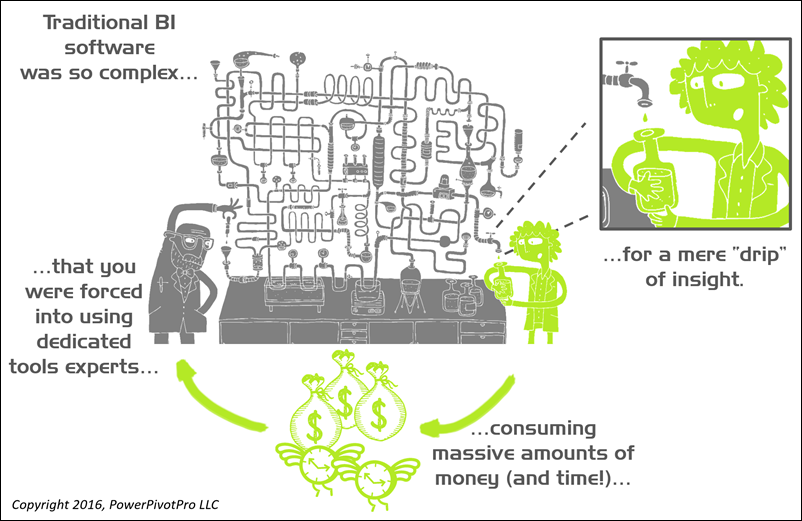
Yep, those were dark times.
Then “Self Service” Tools Entered the Scene!
Power Pivot was Microsoft’s first foray into the “self-service” BI tools market when it released in 2010, but it wasn’t the first or only kid on that particular block. Qlikview for instance was probably the first big player in that space, followed by Tableau, with Microsoft perhaps as the third significant entry. (Maybe TIBCO predated Power Pivot too, not sure).
These tools, despite their differences, all share two key traits:
- They have robust engines under the hood, enabling more responsible/scalable analysis than possible in traditional Excel.
- They are learnable by business users – so in theory, you don’t need the expensive experts anymore.
That’s the marketing message, anyway – your mileage may vary with the different tools. But in my personal experience, in the experience of our team, and the experience of our clients, Power Pivot and its newer cousin Power BI both deliver, BIG TIME, on those promises. (Otherwise we would have moved on to something else by now.)
So… we can revisit that chain of consequences from before…

What does this mean for the consulting industry?
It means two things right off the bat, both of which are incompatible with the old business models:
- Projects become a lot shorter and cheaper overall, seriously undermining the old price points.
- Furthermore, in order for clients to reap the massive benefits conveyed by Power BI and/or Power Pivot, consultants can no longer do most of the work. The client has to be hands-on, directly involved with the execution of the models and analyses!
Shorter, cheaper projects (smaller pie), AND most of the work should be done by the client (smaller fraction of the pie for the consultants)! That’s a big problem right?
Well no, not really, as long as you’re willing to re-invent yourself. Or if, like us, you have the luxury of a blank canvas, unencumbered by past successes in the old model, you can just create a brand-new type of firm from scratch.
Make no mistake: “Self-Service” and “Dependent” are fundamentally at odds with one another. You simply cannot shoe-horn the former into the latter’s pre-existing business model. The market is going to force everyone’s hand in the next few years, and it’s going to be exciting.
Low Cost does NOT mean Low Value – Quite the Opposite.
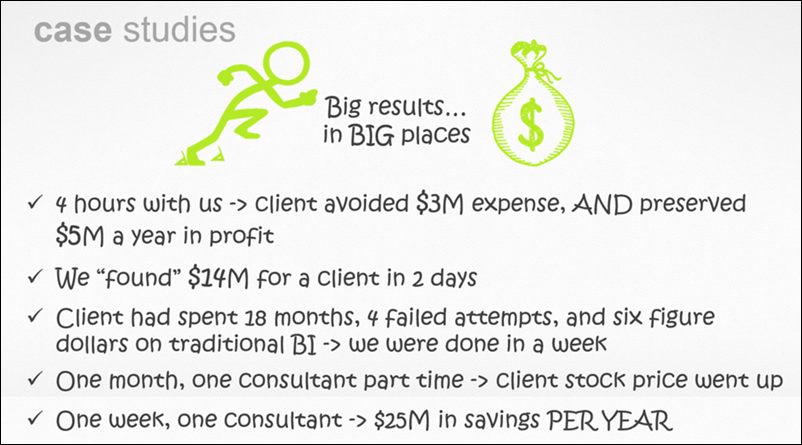
Don’t let the cartoon font fool you: there is BIG value to be found in agile projects.
Counterintuitive at first but absolutely true: using the new methodology, you get MORE value than the old way! Bringing the Business itself right into the “galactic center” of the analytics world has the opposite of a cheapening effect: it delivers massive value. MASSIVE. Much more value than the old methodology in fact – even BEFORE you consider the lower price point. And honestly this shouldn’t surprise us once we think about it, even though it does surprise us at first.
For example, have you ever tried to debug a relative’s computer problem over the phone, versus in person?
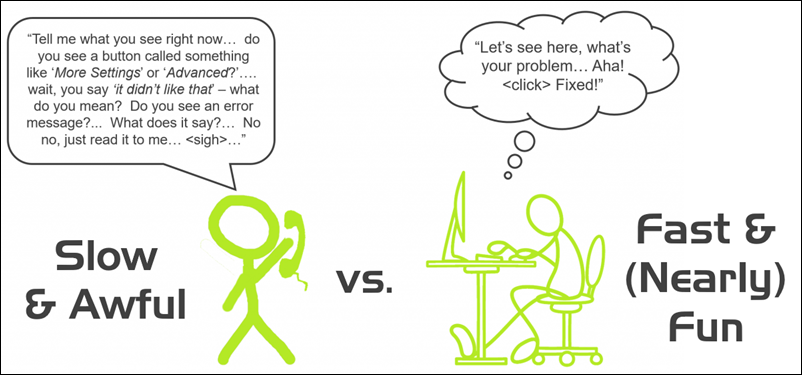
Phone Debugging versus Hands-On Debugging of a Relative’s Computer Problem: Analogous to Traditional vs. Agile BI Consulting
The service at left is much slower, and you’d understandably charge a much bigger fee for it, but the service at right is more valuable to the “client,” at any price.
That analogy illustrates the Communication Cost problem quite well I think: The problems themselves are not so bad. They don’t require calculus, advanced degrees, or esoteric skills. They just require low-friction clarity – a removal of the barriers between “I have a problem” and “I have the skills to solve it.” Communication Cost is everything in the old model – 99% of the cost and time of any project. The new model drops Communication Cost down close to zero.
This Just In: The traditional firms are not really adapting yet.
There are plenty of traditional consulting firms who are “doing” Power BI. But what we’ve long suspected is that they’re merely using Power BI as a new sales vector for the old model: ride the excitement of the self-service tools wave, and once in the door, sell old-school expensive infrastructure projects and “consultant-dependent” BI that’s as heavily-bottlenecked on the consulting firm as it’s always been.

We’ve confirmed this twice in the past year via off-the-record conversations with a very popular and widely-published industry analyst, who told us “When we ask the larger firms whether they ‘do’ self-service BI, they all say yes, but then when we ask them for a case study, they don’t have any. They say they do it, but they don’t actually practice it.”
And to be clear, I am not “accusing” these firms of anything. This isn’t dirty or dishonest behavior on their part – nothing of the sort! They simply have no choice but to behave this way. They are built for the high-overhead, big project, dependent-on-external-experts world. The only way they can help their clients is to apply the methodologies they are built for.
Honestly, in their shoes, I would be starting a new company, a subsidiary perhaps, rather than trying to adapt the existing firm to the new model. And then, eventually, you let the new firm “eat” the parent.
When we ask the larger firms whether they ‘do’ self-service BI, they all say yes, but then when we ask them for a case study, they don’t have any. They say they do it, but they don’t actually practice it.
-A leading industry analyst (who we cannot identify due to his/her firm’s policies)
“So, what’s the inflection point you speak of, Rob?”
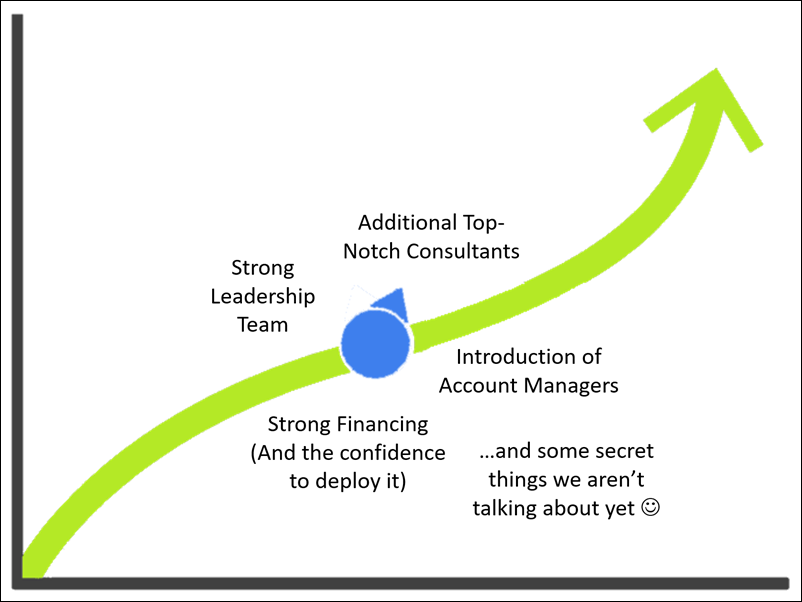
It’s Actually Lots of Things
It’s not one thing really, it’s a bunch of things. And it wasn’t all recent – it’s been happening for a long time. But the cumulative impact has come to a head recently, as if we found a second, larger gas pedal. And the net result is that we’re about to become a lot more aggressive, a lot “louder” on the scene, so to speak.
Guess what? The last year in which I personally performed > 50% of the client work at P3 Adaptive was 2014, and we’ve recently taken me out of the rotation entirely (with the exception of our classes, like the one I am teaching this week in Chicago). This has freed me to focus my efforts elsewhere, in more of a leadership and mentoring capacity, but just as importantly, it’s given me the time to identify the talent we need to grow. Being a geographically-distributed firm has allowed us to comb basically the entire country looking for elite talent, and I’m excited to “confess” that I’m not the most-capable consultant at my own firm. Not even close actually – I might not even be in the top five. Almost certainly not top five, actually, and my ranking falls every time we hire someone new – because the bar is basically “must be better than Rob.” (Not kidding.)
This Spring alone, we’ve signed three new full-time consultants to the team. Stand by for a blog post talking about these simply amazing people, probably titled something like “The People Who Shouldn’t Exist.”
And it’s not just consultants we’ve added. We have slowly built an entire leadership team for instance, which has allowed us to expand our capabilities in many directions. I recently took a bit of a sabbatical, for instance, to deal with some family matters, and the company didn’t miss a beat. (In fact, it moved forward. Hmmm. Moving on.)
Also, in November we quietly created our first-ever “sales” department – which is something I explicitly never wanted to do (because if you’re pressuring people to buy, you’re doing it wrong IMO, and I still believe that). But we also lacked account managers, which meant we were actually making it hard for our clients to use us even as much as THEY wanted to, so we corrected that. Our clients have been better-served as a result – so much so that we’re adding another account manager this week to keep up.
I’m also personally spearheading some very exciting initiatives that we are not yet ready to disclose. Stay tuned.
Operationally, what IS different about running a “new style” firm?
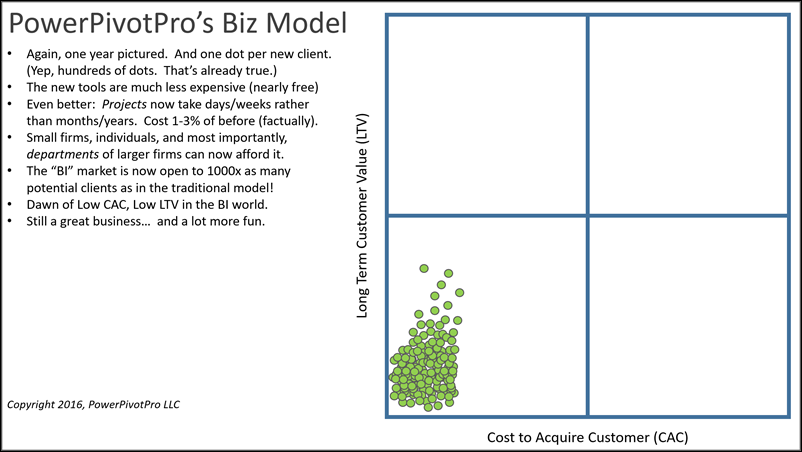
Keep in Mind: “Small-Value” Clients run the Gamut from Small to MASSIVE Organizations
Here are the big differences, some of which are obvious, but others have only become clear to us over the years:
- Since the price point on a single project is FAR lower, you simply CANNOT spend nearly as much to “win” a project. Cold-calling, for instance? Forget it. You have to have a more scalable, cost-effective means for reaching and winning potential clients.
- It’s very tricky to achieve that critical 70-80% utilization of your consulting staff, since you cannot “park” a team of 3-5 people at a single client for months on end like in the old model. If you don’t solve this, you cannot staff with FTE consultants.
- “Teams” of consultants merely drive the price up while simultaneously increasing communication cost, so it’s crucially important that your consultants be able to operate as relatively autonomous individuals. At any given point, the client is almost always only working with one person from our firm.
- To be more clear, you cannot have a separate Solutions Architect (good planner, communicator) paired with teams of “techies” who execute. Consultants need fantastic comm/soft skills, paired with equally-good tech/hard skills, in a single person – and these people, in our experience, are more likely to have come up through the Business than through IT (perhaps for the simple reason that the Business outnumbers IT dramatically, as opposed to something more fundamental).
- You cannot treat Training as a sales funnel. In the self-service world, Training must be a core part of your business, one of the primary values you provide to your clients. All consultants in the new world are inherently trainers… and also consultants! Which merely reinforces point #4 – it’s a new skillset, and many people already on staff at traditional firms just aren’t suited for it.
- Overall, you have to think and operate as an Internet business rather than as a geographically-focused, brick-and-mortar firm. Yes, you absolutely get on airplanes too, but you have to reach, engage, convert, and to a certain extent also service your clients with a mentality akin to that of an Internet startup… while also maintaining a personal connection that’s foreign to the Internet world. Oh, and the same thing goes for staffing your team.
Why am I willing to share all of that?
Why “give away” so much hard-won wisdom, and essentially provide a blueprint for competitors? A few reasons.
- First of all, I kinda just can’t help it. The whole thing is so fascinating that I want to engage others in the conversation. And in some sense, it will be benefit us to have others join us in this space, because critical mass of the New Style in the market will grow demand for our services faster than we can on our own – counterintuitive but true I think.
- Second, my colleagues and I really, truly, believe in this stuff. We’re all here because we’ve seen this Better Way, and we want things to evolve. We want the world to improve, to get smarter. Sounds cheesy but that’s what we’re like in person, too.
- Third, come on! The world of opportunity is so massive in this new model that it’s silly to worry about competitors! Everyone is a potential client, because everyone has data, and everyone can now afford some degree of help! If you’re focusing on the competition rather than on the clients, you’re wasting energy. (More proof that we practice what we preach: some of our clients are other consulting firms, and we help them learn to do what we do.)
- And finally, yes, we DO think it’s hard to follow in our footsteps, even if you have the blueprint. You can’t just snap your fingers and have the kind of team we do, nor can you develop a low-overhead, Internet-scale method for reaching customers overnight. It’s taken us seven years. Maybe you will be faster than that. We kinda hope you will be faster than that. We look forward to you keeping us on our toes.
Get in touch with a P3 team member